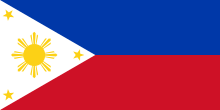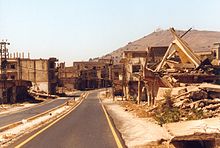Portal:Asia

 Asia (/ˈeɪʒə/ ⓘ AY-zhə, UK also /ˈeɪʃə/ AY-shə) is the largest continent in the world by both land area and population. It covers an area of more than 44 million square kilometers, about 30% of Earth's total land area and 8% of Earth's total surface area. The continent, which has long been home to the majority of the human population, was the site of many of the first civilizations. Its 4.7 billion people constitute roughly 60% of the world's population. Asia shares the landmass of Eurasia with Europe, and of Afro-Eurasia with both Europe and Africa. In general terms, it is bounded on the east by the Pacific Ocean, on the south by the Indian Ocean, and on the north by the Arctic Ocean. The border of Asia with Europe is a historical and cultural construct, as there is no clear physical and geographical separation between them. It is somewhat arbitrary and has moved since its first conception in classical antiquity. The division of Eurasia into two continents reflects East–West cultural, linguistic, and ethnic differences, some of which vary on a spectrum rather than with a sharp dividing line. A commonly accepted division places Asia to the east of the Suez Canal separating it from Africa; and to the east of the Turkish Straits, the Ural Mountains and Ural River, and to the south of the Caucasus Mountains and the Caspian and Black seas, separating it from Europe. China and India traded places as the largest economies in the world from 1 to 1800 CE. China was a major economic power for much of recorded history, with the highest GDP per capita until 1500. The Silk Road became the main east–west trading route in the Asian hinterlands while the Straits of Malacca stood as a major sea route. Asia has exhibited economic dynamism as well as robust population growth during the 20th century, but overall population growth has since fallen. Asia was the birthplace of most of the world's mainstream religions including Hinduism, Zoroastrianism, Judaism, Jainism, Buddhism, Confucianism, Taoism, Christianity, Islam, Sikhism, as well as many other religions. (Full article...) Featured articleQuneitra (also Al Qunaytirah, Qunaitira, or Kuneitra; Arabic: ٱلْقُنَيْطِرَة or ٱلْقُنَيطْرَة, al-Qunayṭrah or al-Qunayṭirah pronounced [æl qʊˈneɪ̯tˁ(ɨ)rɑ]) is the largely destroyed and abandoned capital of the Quneitra Governorate in south-western Syria. It is situated in a high valley in the Golan Heights at 1,010 metres (3,313 feet) above sea level. Since 1974, pursuant to United Nations Security Council Resolution 350 and the Agreement on Disengagement between Israel and Syria, the city is inside the UN-patrolled buffer zone. Quneitra was founded in the Ottoman era as a way station on the caravan route to Damascus and subsequently became a garrison town of some 20,000 people. In 1946, it became part of the independent Syrian Republic within the Riff Dimashq Governorate and in 1964 became the capital of the split Quneitra Governorate. On 10 June 1967, the last day of the Six-Day War, Quneitra came under Israeli control. It was briefly recaptured by Syria during the 1973 Yom Kippur War, but Israel regained control in its subsequent counter-offensive. The city was almost completely destroyed by Israel before it withdrew in June 1974. Syria later refused to rebuild the city and actively discouraged resettlement in the area. Israel was heavily criticized by the United Nations for the city's destruction, while Israel has also criticized Syria for not rebuilding Quneitra. (Full article...)Selected Country The Philippines, officially the Republic of the Philippines, is an archipelagic country in Southeast Asia. In the western Pacific Ocean, it consists of 7,641 islands, with a total area of 300,000 square kilometers, which are broadly categorized in three main geographical divisions from north to south: Luzon, Visayas, and Mindanao. The Philippines is bounded by the South China Sea to the west, the Philippine Sea to the east, and the Celebes Sea to the south. It shares maritime borders with Taiwan to the north, Japan to the northeast, Palau to the east and southeast, Indonesia to the south, Malaysia to the southwest, Vietnam to the west, and China to the northwest. It is the world's twelfth-most-populous country, with diverse ethnicities and cultures. Manila is the country's capital, and its most populated city is Quezon City. Both are within Metro Manila. Negritos, the archipelago's earliest inhabitants, were followed by waves of Austronesian peoples. The adoption of Animism, Hinduism with Buddhist influence, and Islam established island-kingdoms ruled by datus, rajas, and sultans. Overseas trade with neighbors such as the late Tang or Song empire brought Sinitic-speaking Sangley / "Langlang" merchants to the archipelago, which would gradually settle in and intermix. The arrival of Ferdinand Magellan, a Portuguese explorer leading a fleet for Castile, marked the beginning of Spanish colonization. In 1543, Spanish explorer Ruy López de Villalobos named the archipelago Las Islas Filipinas in honor of King Philip II of Castile. Spanish colonization via New Spain, beginning in 1565, led to the Philippines becoming ruled by the Crown of Castile, as part of the Spanish Empire, for more than 300 years. Catholic Christianity became the dominant religion, and Manila became the western hub of trans-Pacific trade. Hispanic immigrants from Latin America and Iberia would also selectively colonize. The Philippine Revolution began in 1896, and became entwined with the 1898 Spanish–American War. Spain ceded the territory to the United States, and Filipino revolutionaries declared the First Philippine Republic. The ensuing Philippine–American War ended with the United States controlling the territory until the Japanese invasion of the islands during World War II. After the United States retook the Philippines from the Japanese, the Philippines became independent in 1946. The country has had a tumultuous experience with democracy, which included the overthrow of a decades-long dictatorship in a nonviolent revolution. (Full article...)Featured biographyZhou Tong (Chinese: 周同 and 周侗; pinyin: Zhōu Tóng) (died late 1121 CE) was the archery teacher and second military arts tutor of famous Song dynasty general Yue Fei. Originally a local hero from Henan, he was hired to continue Yue Fei's military training in archery after the boy had rapidly mastered spearplay under his first teacher. In addition to the future general, Zhou accepted other children as archery pupils. During his tutelage, Zhou taught the children all of his skills and even rewarded Yue with his two favorite bows because he was his best pupil. After Zhou's death, Yue would regularly visit his tomb twice a month and perform unorthodox sacrifices that far surpassed that done for even beloved tutors. Yue later taught what he had learned from Zhou to his soldiers and they were successful in battle. With the publishing of Yue Fei's 17th folklore biography, The Story of Yue Fei (1684), a new, fictional Zhou Tong emerged, who differed greatly from his historical persona. Not only was he now from Shaanxi, but he was Yue's adopted father, a learned scholar with knowledge of the eighteen weapons of war, and his personal name was spelled with a different, yet related, Chinese character. The novel's author portrayed him as an elderly widower and military arts tutor who counted Lin Chong and Lu Junyi, two of the fictional 108 outlaws on which the Water Margin is based, among his former pupils. A later republican era folktale by noted Yangzhou storyteller Wang Shaotang not only adds Wu Song to this list, but represents Zhou as a knight-errant with supreme swordsmanship. The tale also gives him the nickname "Iron Arm", which he shares with the executioner-turned-outlaw Cai Fu, and makes the outlaw Lu Zhishen his sworn brother. Because of his association with the outlaws, he is often confused with the similarly named outlaw Zhou Tong. (Full article...)General imagesThe following are images from various Asia-related articles on Wikipedia. Featured picture Credit: Pratheepps The Toda people are a small pastoral tribe of less than 1,000 people who reside in the Nilgiri hills of Southern India. Shown here is a typical Toda hut, about 3 m (10 ft.) high, 5.5 m (18 ft.) long and 2.7 m (9 ft.) wide. They are built of bamboo fastened with rattan and thatched. The hut has only a tiny (about 0.9 x 0.9 m, 3 x 3 ft.) entrance at the front, which serves as protection from wild animals.
Did you know...
Updated: 6:33, 14 February 2024 In the news
Related portalsMajor Religions in Asia Middle East Central Asia and Surroundings Indian Subcontinent Southeast Asia East Asia Selected panorama
The Buriganga River flows past the southwest outskirts of Dhaka, the capital of Bangladesh. Its average depth is 7.6 metres (25 ft) and its maximum depth is 18 metres (58 ft). TopicsCategoriesAssociated WikimediaThe following Wikimedia Foundation sister projects provide more on this subject:
More portalsShortcuts to this page: Asia portal • P:ASIA Purge server cache |






























































































